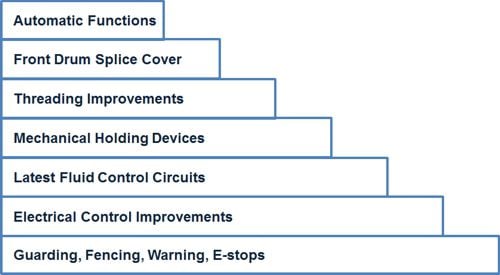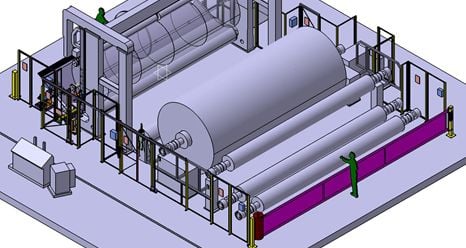Webinar presents ways to improve safety around the winder
[NOTE: The "Improving winder safety" webinar has been archived and is now available HERE.]
The batch process occurring five to ten times per hour at the winder represents one of highest potential areas of danger in the mill for operators and maintenance personnel. Speeds and technology continue to increase. Regulations are changing (e.g. EN ISO 13849 machinery standards).

Retrofitting safety improvements is possible (1950s era vs. modern winder)
This gives rise to several safety-related questions. How safe is safe enough? Will a safety upgrade reduce overall throughput? Will automating some winder functions improve both safety and productivity? How much downtime will be required?
These and more questions were answered in webinar hosted by TAPPI and presented by Valmet winder safety experts. Included in the discussion were guards, fencing, E-stops, electrical and fluid control improvements, mechanical holding devices, threading and splicing modifications and automation. Improving safety at the winder typically starts with basic fencing and guards with interlocked safety zones, and continues in complexity depending on desired safety level and production capacity.

Winder safety improvement steps
In the example shown in the following figure, a two drum winder was upgraded with safety fencing, interlocked safety zones and gates, a retractable unwind fence, discharge and slitter area light curtains, pit guard, mechanical stops for the lowering cradle and core chucks, threading and splicing improvements, rider roll pneumatic brakes and pivoting core tray.

This relatively complex safety-driven rebuild of a two drum winder involved most of the safety improvement steps mentioned earlier.
On Wednesday, August 3rd, 2016, Valmet winder/safety experts updated an audience of papermakers about what their options are and what several mills have done in recent years to improve the safety in the winder area. They started with a review of the new changes in machinery standards and then dissected a number of winder safety-driven rebuilds including examples of each type of winder safety improvement.
For more informaton on winder safety, view the webinar and contact your Valmet representative.
